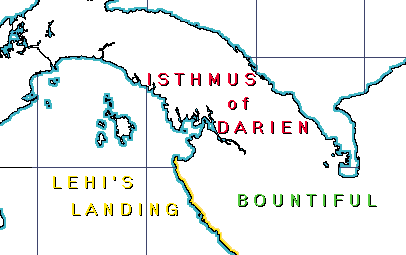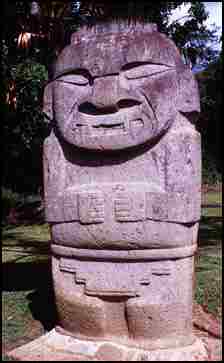THE LOGIC OF THE NARROW NECK OF LAND
By Don R. Hender


 There is logic that supports the disagreement with the Panama
region being the small neck of the Book of Mormon. Some contend
that the vastness of the North and South American continents are
just too large for the more confined lands described by the Book of
Mormon. Others point out that so vast was the destructive changes
during the upheaval at Christ's death described in the Book of
Mormon; that there is no way to say where the small neck of land
was for sure. Yet the obvious is the Lands of Panama and rather
than try to support it or disprove it; lets see what the Prophet
and the Book itself says about the matter.
There is logic that supports the disagreement with the Panama
region being the small neck of the Book of Mormon. Some contend
that the vastness of the North and South American continents are
just too large for the more confined lands described by the Book of
Mormon. Others point out that so vast was the destructive changes
during the upheaval at Christ's death described in the Book of
Mormon; that there is no way to say where the small neck of land
was for sure. Yet the obvious is the Lands of Panama and rather
than try to support it or disprove it; lets see what the Prophet
and the Book itself says about the matter.
Some 25 years after the Nephites had began to settle the lands north of the small or narrow neck of land, the Book of Mormon delineates the over all picture of the two great lands. As stated in the Book of Mormon, Lehi was brought to the 'Land South' and Mulek's group landed in the land North (Helaman 6:10; Alma 22:30). Thus, even though Mulek's group migrated down into the Land of Zarahemla (Colombia), the land north, which was previously called Desolation, was then called the Land of Mulek, as it was the land where Mulek first landed and found Coriantumr the Jaredite.
Logic would say that at least all the land from where Lehi originally landed and southward would be south of the narrow neck of land, as described in the Book of Mormon, and thus part of the land southward. So where did Lehi land?
 Given that Lehi landed where the Prophet Joseph Smith indicated,
and given that the small and narrow neck of land that separated the
lands south and north is that of Panama; is there any logical
support in the Book of Mormon as why Lehi would have to land so
close to the small neck of land and the land northward?
Given that Lehi landed where the Prophet Joseph Smith indicated,
and given that the small and narrow neck of land that separated the
lands south and north is that of Panama; is there any logical
support in the Book of Mormon as why Lehi would have to land so
close to the small neck of land and the land northward?Recall that the flood of Noah covered all the earth and in the days of Peleg was the earth divided. Recall that the Jaredites had to bring their own domestic animals with them when they sailed in their barges to America (Ether 1:41 & 6:4). And why did the Jaredites have to bring their own domestic animals with them? Because domestic animals were not to be found otherwise on the Americas. Now, did Lehi's group bring ships or barge loads of domestic animals with them like the Jaredites did? No! And why not? Because domestic animals where already here due to the Jaredites bring them. But now, were the domesticated animals on both the north and south lands of the Americas? And how and why?
Of course domestic animals where on the land north as that was the land of the Jaredites, right? And they brought them with them. Yet the description of the last wars of the Jaredites might suggest otherwise, as their wars where wars of annihilation and they would sweep the land clean of crop and beast as they would war to the death (Ether 14:18).
Were domestic animals on the land south. The Jaredites had preserved the land south as a 'wild' wilderness preserve (Ether 10:21). They didn't even inhabit it but for safaris and the like. Yet when Lehi landed on the land south, the domestic animals of the Jaredites where here. There was the cow and the ox, the ass and the horse, and the goat and the wild goat as well as all manner of wild animals (1 Nephi 18:25).
How did the domestic animals come to occupy the northern portions of the land south? Well, the Book of Mormon tells of poisonous serpents driving the domestic animals from the land north into the land south and hedging up the way to prohibit the Jaredites from chasing after them and retrieving them back into the land north (Ether 9:31-35). Now carefully note the wording, '...And it came to pass that their flocks began to flee before the poisonous serpents, towards the land southward, which was called by the Nephites Zarahemla." (Ether 9:31) So there could have been a residue of some such animals strewn in the land south, but that was 'way' before the time of Lehi that the poisonous snake event. But some relatively 'tame' animals may have survived the time such as the lama and what not.
Now, where did Lehi land? Just south of Darien. Where were the flocks of the Jaredites driven to? Toward Zarahemla or the northern regions of the land south to begin with. Where did Lehi's colony find the domestic animals during their travel in the wilderness? Is Colombia the land of Zarahemla? Wait, I will write another article that will further support from actual archeological, geological, and geographical evidences that it is. But for now, Lehi found the domestic animals of the Jaredites just where the serpents had driven them after so many years? That is just south of the small narrow neck of land and just a little south of the Isthmus of Darien where Joseph Smith said that Lehi landed.
Now if poisonous snakes and hundreds of years wait is not enough, there is an addition to this, consider the land Bountiful. The exact phrase "all manner of wild animals" is only used twice in the Book of Mormon. Once in 1 Nephi 18:25 where upon Lehi's landing the colony first journeyed into the wilderness of the new land and there found both domestic animals and wild beast 'of every kind.' And second in Alma 22:31 when referring to the land Bountiful where it is specifically stated as being ' the wilderness which is filled with "all manner of wild animals" of every kind, ... which had come from the land northward for food.'
So why is this significant? Perhaps it is only coincidence. But recall the Book of Mormon was written in a symbolic Reformed Egyptian shorthand where each Egyptian symbol or notation represented a 'word phrase' or thought. Therefore the Reformed Egyptian symbol for "all manner of wild animals" was only used twice. Once in the wilderness where Lehi landed and once where it was stated about Bountiful that this was 'the wilderness' filled with 'all manner of wild animals.' Coincidence? Or is the Book of Mormon telling us something and can we read and understand what it is saying to us?
 As a fan of jigsaw puzzles, it seems that you know you are getting
somewhere when the pieces begin to fit consistently and to reveal
an over
all image or picture that fits reality. This and other facts, I am
aware of,
make Bountiful the land of South Darien and Northwest Colombia. It
makes
Hermounts refer to the Central and Western/Occidental Cordilleras.
And it
makes the Valley del Magdalena that of the central land and city of
Zarahemla. It makes the city of Ammonihah located in the north end
of the Cauca lower valley southeast of Bountiful and on the borders
of the wilderness of Hermounts or South Bountiful. This is where
these wild beast would in one day lay waste the carcasses of the
Ammonihahites (Alma 16:9-10). It further makes the head waters of
the River Sidon match those of the Magdalena River and the
archeological site near San Agustin match the atmosphere of an
out-post frontier city that Manti must have been with fierce statue
monuments of warnings to the Lamanites or visa versa. This being on
the edge of the narrow strip of wilderness that separated the Lamanites
from the Nephites (Alma 22:27-34).
As a fan of jigsaw puzzles, it seems that you know you are getting
somewhere when the pieces begin to fit consistently and to reveal
an over
all image or picture that fits reality. This and other facts, I am
aware of,
make Bountiful the land of South Darien and Northwest Colombia. It
makes
Hermounts refer to the Central and Western/Occidental Cordilleras.
And it
makes the Valley del Magdalena that of the central land and city of
Zarahemla. It makes the city of Ammonihah located in the north end
of the Cauca lower valley southeast of Bountiful and on the borders
of the wilderness of Hermounts or South Bountiful. This is where
these wild beast would in one day lay waste the carcasses of the
Ammonihahites (Alma 16:9-10). It further makes the head waters of
the River Sidon match those of the Magdalena River and the
archeological site near San Agustin match the atmosphere of an
out-post frontier city that Manti must have been with fierce statue
monuments of warnings to the Lamanites or visa versa. This being on
the edge of the narrow strip of wilderness that separated the Lamanites
from the Nephites (Alma 22:27-34).
One final note of irony. Hagoth, either knowingly or unknowingly would have set sail from the same general location that Lehi's original colony landed. Note Alma 63:5 where he launches his ship on the border of Bountiful by the land Desolation which was located by the narrow neck which led into the land northward on the west. Some coincidence or was it knowingly designed that way by Hagoth?